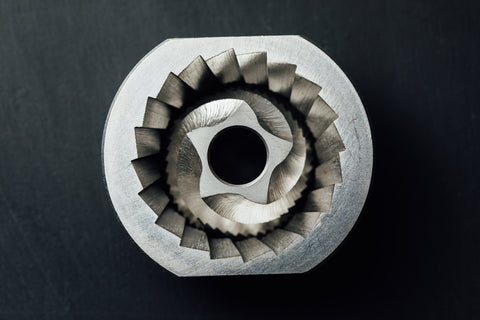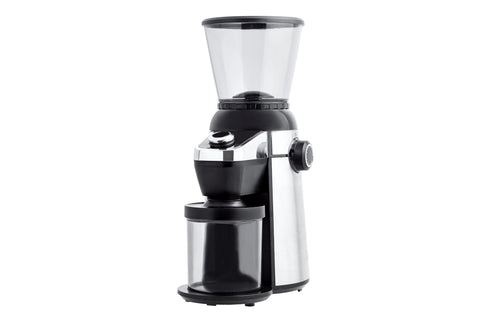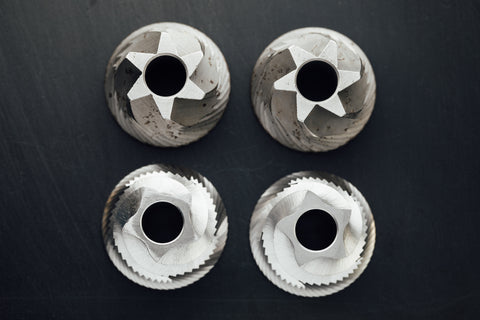Flat Burr Coffee Grinder Vs. Conical Burr Coffee Grinder: Is One Better Than The Other?
Coffee aficionados know that the key to a great cup of coffee lies in how you grind your beans. For those looking for an upgrade from their standard blade grinder, two popular choices are flat burr and conical burr coffee grinders. But which one is best?

Photo by DmitryPoch / Depositphotos
When looking at the debate between a flat burr coffee grinder and a conical burr coffee grinder, the opinion is split. While some are proponents of a flat burr grinder for its greater consistency of grind size, others prefer the conical option for its quieter nature and fewer parts to clean. When comparing, it is found that neither model is necessarily better than the other. Ultimately, it comes down to personal preference when deciding which one might suit you best. Whether you favor convenience or finesse, precision or productivity, both models have been designed to fit the consumers’ needs and preferences.
In this blog post, we’ll explore the differences between these two types of grinders so you can decide which one will work best for you. We’ll look at things like cost, convenience, taste, quality, and more to help you decide if a flat burr or conical burr grinder is right for your home brewing needs. So grab yourself a fresh cup of joe, and let’s dive in!
1. What Are Flat and Conical Burr Coffee Grinders?
Flat and conical burr coffee grinders offer coffee lovers the opportunity to take their cup of coffee to a higher level. Flat burrs, with two horizontally mounted flat plates, provide the ideal setting to grind coffee for espresso and Turkish coffees. Conical Burr grinders consist of two cone-shaped rings that sit one inside another. This setup is better suited for grinding beans for all other types of flavored coffees.
In either case, these burr grinders are designed to optimize efficiency and consistency, bringing joy to those seeking that perfect beverage at home. If you are someone who doesn’t mind investing a few extra bucks for a personal coffee grinder, perfection can be achieved right in your kitchen!
2. How Often Should You Clean Grinder Burrs?

Photo by nikkytok / Depositphotos
Cleaning your grinder burrs on a regular basis should be part of your coffee-making routine. If you’re someone who just drinks a few cups of coffee per day, aim to give your grinder burrs a thorough cleaning about once every two weeks. This will ensure that the grind remains consistent and the amount of static buildup is minimized.
But if you’re seriously committed to enjoying the perfect cup of joe several times a day, then you may need to consider increasing the frequency of your burr cleanings. The more often you use your grinder, the more often these tiny blades need some tender loving care!
The frequency of cleaning also depends on the type of roast you are using to grind. The darker roasts require cleaning more often as they tend to leave more residue.
With regular cleanings, your morning (or afternoon) cup will taste better than ever — so make sure that burr cleaning doesn’t become one of those unpleasant tasks that stays forever at the bottom of your to-do list.
3. Which Is The Best Coffee Grinder For Home Use?
If you’re looking for the best coffee grinder for home use, conical burr grinders have got you covered! These heavy-duty machines provide convenience and affordability, with adjustable grind levels and noiseless operation. Plus, their capacity and size make them an excellent fit for any kitchen. So what are you waiting for? Get grinding those beans in style and enjoy that delicious cup of freshly ground coffee every day!

Photo by BespaliyA / Depositphotos
4. How Many Seconds Should I Grind Coffee?
For the perfect cup of coffee, you’ll want to consider how many seconds you should grind your beans. A coarse grind is ideal for a French press and takes only 8-10 seconds– start with a few short bursts to achieve the desired consistency.
If you’re prepping for drip coffee, then aim for a medium grind which requires 10-15 second bursts. And finally, if you prefer an even finer powder-like texture for espresso, keep grinding (with short breaks in between) until it’s achieved– this could be 10 seconds or more. Get ready to sip your way to delicious coffee perfection!
5. How To Clean A Burr Coffee Grinder?
Keeping your beloved burr coffee grinder in top condition is an easy task when you follow these simple steps:
- After unplugging the power cord, remove the hopper and clean the hopper to remove all grounds and foreign particles. Use hot soapy water to clean the hopper. Rinse the parts thoroughly.
- Unscrew any pieces that come apart – rubber, plastic, and the grind chamber. Wash them with soapy water.
- Remove the inner burrs with a small screwdriver.
- Give everything a good scrub with a brush, wipe down the burrs, and then clean out the coffee chute – so nothing gets caught inside. Feel free to use a toothpick to clean the coffee debris from unreachable corners.
- Wipe all the parts with a damp towel.
-
Let everything air dry before reassembling your grinder so it’s ready for action!

Photo by nikkytok / Depositphotos
With this few-step routine, your coffee grinder will be sparkling clean!
When it comes to grinding coffee beans, there are two main types of grinders: flat burr and conical burr. While both will get the job done with fine results, both have distinct advantages and disadvantages in output quality, convenience, and longevity.
Flat burr grinders produce a uniform grind size that is ideal for consistency in the brewing process but generally requires more time and effort to clean than conical burrs. Additionally, flat burrs generate more heat in their grinding process, which can affect taste adversely — although some argue that this adds an extra layer of flavor to the final product.
Conical burrs, on the other hand, yield grinder particles with a more varied size range which can boost the flavor if used correctly but also has limits if you are looking for precision grind size control. In terms of convenience and maintenance, conical burrs tend to win out over flat burrs since the smaller pieces retain less residue between usages. Ultimately, it really depends on what kind of brew you desire, as both grinders are sure to provide great tasting coffee – no matter which way you choose!

